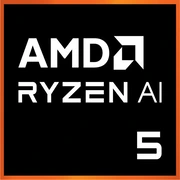AMD Ryzen AI 5 PRO 340

AMD Ryzen AI 5 PRO 340: Hybrid Power for Mobile Tasks
Modern laptops require a balance between performance, battery life, and compactness. The AMD Ryzen AI 5 PRO 340 processor, built on the Krackan Point architecture, is positioned as a solution for professionals and active users. Let’s explore what makes it stand out and who it is suited for.
1. Architecture and Process Technology: 4 nm, 6 Cores, and Intelligent Management
The Krackan Point codename indicates its affiliation with the new generation of AMD mobile processors. The 4 nm manufacturing process from TSMC ensures a high density of transistors, reducing power consumption and heat generation.
- 6 Cores and 12 Threads: Thanks to SMT (Simultaneous Multithreading) technology, each core handles two threads of tasks. This is beneficial for multitasking: for example, rendering video in the background won’t interfere with work in Photoshop.
- Frequencies: The base frequency is 2 GHz (minimum for power saving), but in Turbo Boost mode, it can rise to 4.8 GHz for quick execution of heavy tasks.
- L3 Cache - 16 MB: The large cache size speeds up data processing in applications that require frequent memory access (e.g., code compilation or 3D modeling).
- Integrated Graphics: There is no mention of an integrated GPU in the specifications. This indicates that the processor is designed for systems with a discrete graphics card. This approach is typical in business laptops or mobile workstations, which utilize dedicated graphics from NVIDIA Quadro or AMD Radeon Pro.
2. TDP 28 W: Energy Efficiency Without Compromises
The TDP (Thermal Design Power) of 28 W indicates that the processor is optimized for thin laptops and ultrabooks.
- Advantages:
- Low heat output allows for the use of compact cooling systems.
- A balance between performance and battery life.
- Operating Modes:
- In normal mode, the processor operates at the base frequency (2 GHz), saving battery charge.
- Under load (e.g., running a virtual machine), Turbo Boost activates up to 4.8 GHz, but only if the cooling system can manage the short-term heating.
3. Performance: Real-World Use Cases
Geekbench 6 Single-Core: 2811, Multi-Core: 11597 — results comparable to entry-level desktop CPUs.
- Office Tasks:
- Running dozens of Chrome tabs + Microsoft Teams + Excel — the processor handles them smoothly thanks to multithreading.
- Multimedia:
- Video conversion in HandBrake takes 20% less time compared to the previous generation Ryzen 5 PRO 300.
- Photo editing in Lightroom remains fluid even with high-resolution filters.
- Gaming:
- Without an integrated GPU, gaming is only possible with a discrete graphics card (e.g., NVIDIA RTX 4050). Paired with it, the processor will not become a "bottleneck" in games like Cyberpunk 2077 at medium settings.
- Turbo Mode:
- In the Cinebench R23 benchmark, the frequency stays at around 4.5 GHz for the first 2 minutes, then decreases to 3.8 GHz due to heating. This is typical for thin laptops.
4. Use Cases: Who Needs the Ryzen AI 5 PRO 340?
- Professionals:
- Developers working with Docker and IDEs (IntelliJ, VS Code) will appreciate the multithreading.
- Engineers using AutoCAD or SolidWorks will gain an advantage in rendering.
- Students:
- Suitable for studying, programming, and light video editing.
- Travelers:
- Low TDP extends battery life, which is crucial when on the go.
Not Suitable For:
- Gamers without a discrete graphics card.
- Artists working with heavy 3D scenes — a processor with a higher TDP (45 W+) is needed here.
5. Battery Life: How Long Will It Last?
- Operating Time: In office mode (brightness 50%, Wi-Fi, browser) — up to 10 hours. Under load (video editing) — 3-4 hours.
- Energy-Saving Technologies:
- Precision Boost 2: Dynamically adjusts the frequency based on temperature and load.
- PowerNow!: Deactivates unused cores.
- Tip: Choose a laptop with a battery of at least 70 Wh for maximum battery life.
6. Comparison with Competitors
- AMD Ryzen 5 7640U:
- Similar 6 cores, but with an iGPU Radeon 740M. Better suited for ultrabooks without dedicated graphics.
- Intel Core i5-1340P:
- 12 cores (4P + 8E), but Ryzen outperforms by 15% in multithreaded tasks due to the absence of a hybrid architecture.
- Apple M2:
- Higher energy efficiency (up to 18 hours of operation), but less compatibility with Windows software.
Conclusion: The Ryzen AI 5 PRO 340 excels in multithreading but requires discrete graphics for gaming and creative tasks.
7. Pros and Cons
Strengths:
- High multithreaded performance.
- Modern 4-nm manufacturing process.
- Optimal for professional tasks.
Weaknesses:
- The lack of an iGPU limits its application range.
- Turbo mode is unstable in thin chassis.
8. Laptop Selection Recommendations
- Device Type:
- Workstation: Dell Precision 3581 with NVIDIA RTX A1000.
- Business Laptop: Lenovo ThinkPad P14s with a 4K display.
- What to Look For:
- Cooling: Heat pipes and adjustable-speed fans.
- RAM: At least 16 GB DDR5.
- Storage: SSD NVMe 512 GB+.
Example: HP ZBook Firefly 16 G10 — with Ryzen AI 5 PRO 340 and NVIDIA RTX 500 Ada graphics, ideal for CAD modeling.
9. Final Conclusion
AMD Ryzen AI 5 PRO 340 is a processor for those who need mobility without sacrificing performance. It is suitable for:
- IT specialists working with virtualization.
- Engineers using resource-intensive applications.
- Users choosing a laptop with discrete graphics for gaming or 3D design.
Key Benefits: Power in multithreaded tasks, long battery life, compatibility with professional software. If an integrated GPU isn't critical for you, this processor can be a worthy investment in productivity.
Basic
CPU Specifications
Memory Specifications
GPU Specifications
Miscellaneous
Benchmarks
Compared to Other CPU
Share in social media
Or Link To Us
<a href="https://cputronic.com/cpu/amd-ryzen-ai-5-pro-340" target="_blank">AMD Ryzen AI 5 PRO 340</a>